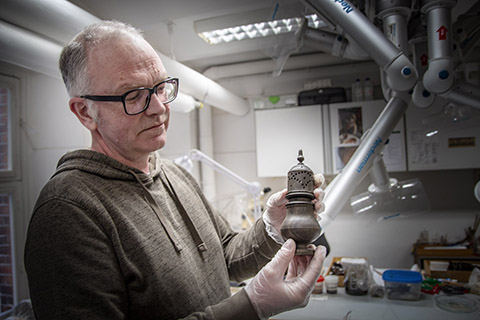
How to preserve findings in the mud
Gert stops time
Conservator Gert van Oortmerssen has dozens of objects spread out across his table: a three-hundred-year-old awl, a wooden vial the size of a perfume bottle, a handle that may once have been attached to the lid of a barrel, a comb, and even a pair of shoes.

‘Look at this spoon’, says Van Oortmerssen, while he unwraps a spoon from a piece of cloth with his gloved hands. ‘This is the most important find as far as I’m concerned.’ The spoon is a small work of art; it probably wasn’t used for eating. It belonged to one of the ship’s wealthier passengers and was a sign of status.
The objects on the table were all found in the thirty-metre long shipwreck, which was discovered in the Noordoostpolder in 2016. A farmer found it while he was ploughing his field.
The vessel was an eighteenth-century English merchant ship filled with interesting artefacts, stranded in the then Zuyder Zee approximately three hundred years ago. The artefacts were individually dug up after RUG archaeologists, led by maritime archaeologist Yftinus van Popta, started the recovery process last year.
Silk glove
The team found royal portrait spoons from London which date back hundreds of years and depict Queen Anne, dozens of leather shoes, and a woolly hat. They also found bullets, wine and beer bottles, cannons, and the ship’s cat’s skull. ‘We even found a silk glove. It probably belonged to a lady!’
If you don’t preserve your findings you lose important information
Conservator Van Oortmerssen made sure that the findings were handled and packaged correctly. Practically all the objects, including things made of organic material such as wood, leather, or textile, were found in really good condition.

Now it’s just a matter of preservation. In August of last year, Van Oortmerssen started cleaning, preserving, and restoring the various artefacts in the basement of the Groningen Institute of Archaeology. ‘I’m working on the leather and wooden objects right now’, he says.
This is especially important, because the wreck was submerged in the soft Zuyder Zee seabed and was therefore submerged in salt water. When the area was impoldered (land reclamation), the wreck became part of the Noordoostpolder. At the time the ship was found, it was located in part below groundwater level, and everything was waterlogged. If the wood is allowed to air-dry, there’s a good chance it will tear and warp. The same goes for leather: if you dry out sopping wet leather shoes, they become hard as a rock and will tear.
This means wood and leather need to be treated and preserved. ‘If you don’t, you lose important information’, Van Oortmerssen explains. Immediately after they’ve been dug up, the wood and leather findings are put into bags with water to prevent them from air-drying.

Acetone bath
Once they arrive at the depot, the water in the objects is replaced by either ethanol (for the leather) or acetone (for the wood). Van Oortmerssen places the wood in an acetone bath, upon which the water in the wood is drawn out, and the acetone drawn in. This process is continued until there is as much water in the wood as there is in the surrounding fluid. This means Van Oortmerssen has to repeat the process until the object is completely filled with acetone.
He then submerges the object in a heated acetone bath that also contains dissolved resin. ‘It’s like boiling something au bain-marie.’ After approximately a month, the object has been sufficiently impregnated. Once it’s dried, the resin ensures it retains its shape.
The process for leather is similar, except it uses ethanol, and the leather objects are impregnated with castor oil and glycerol. Every object needs a unique process, Van Oortmerssen says.
‘Take this comb’, he says, picking up a small, curved bone comb. Its water has been replaced with ethanol, and it’s been impregnated with diluted restoration glue. ‘It’s made the comb look like it’s made from plastic’, he says. ‘The glue got between the teeth, see? But that’s okay, I’ll keep working on it.’ He will also reattach the two loose teeth that were found during the excavation.
Iron is another matter altogether. First of all, he only touches that while wearing gloves. ‘There is salt on our skin’, he explains, ‘which could corrode the objects.’

Cannons
Chloride salts can speed up corrosion for metal. Van Oortmerssen is currently installing a heat plate beneath a kitchen sink to desalinate the cannons found in the wreck. ‘I put them in a chemical mix, consisting of sodium hydroxide and sodium sulphite, and leave them to soak for months.’
When the cannons are done soaking, Van Oortmerssen treats them with a tannin solution and impregnates them with glue, so that he ends up with a shiny cannon. By then treating it with acid-free wax, he ensures that the cannon is further preserved, and the wax returns it to its natural, matt finish.
He throws almost nothing away. Even the water that was used to clean the comb is currently in a jar labelled ‘comb water’. If you put a drop of the water under a microscope, you can see lice. It may be gross, ‘but people had them in those days as well!’
The spoons, the clothes, the little draughts piece that people played with: ‘every object has its own story, a connection to people who were once alive. That’s why it’s so important to preserve them. In the end all these artefacts serve to tell a story about how people lived and survived in the past.’


